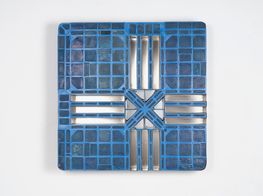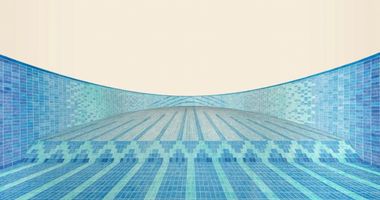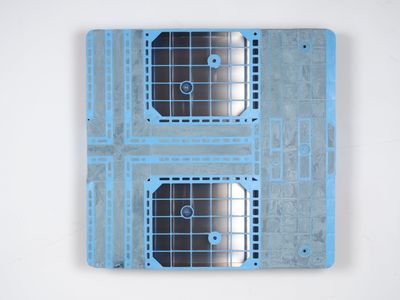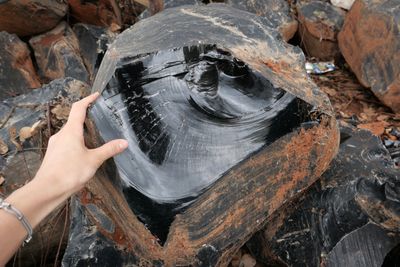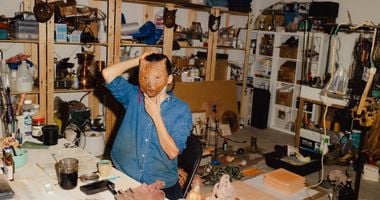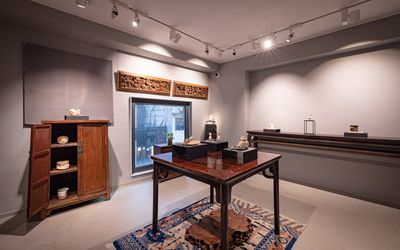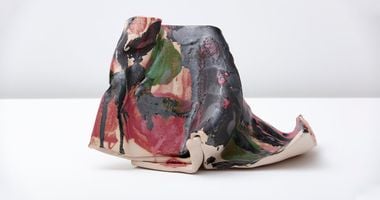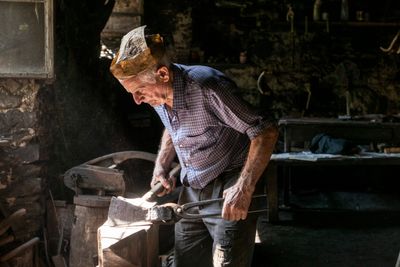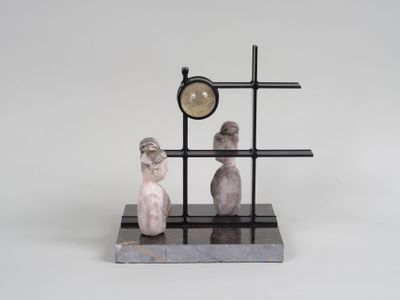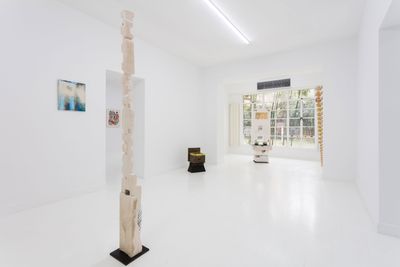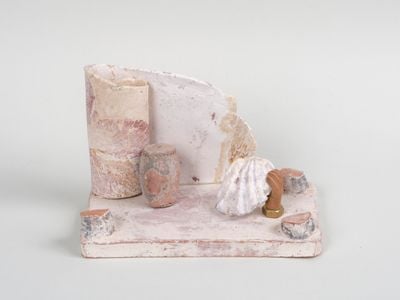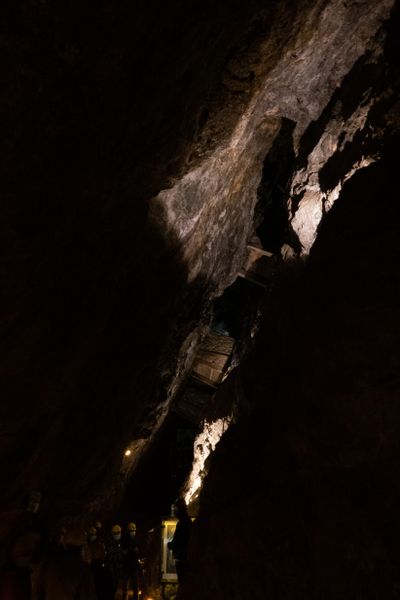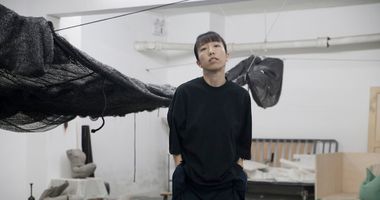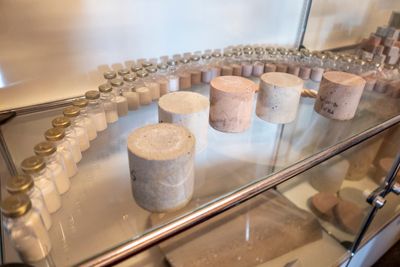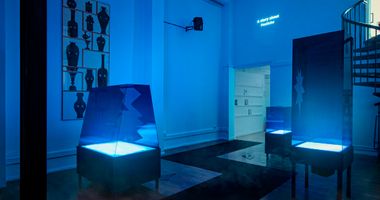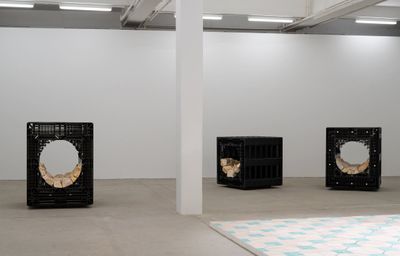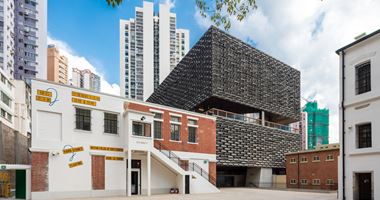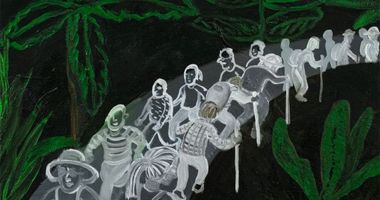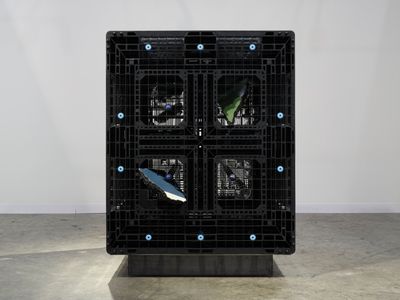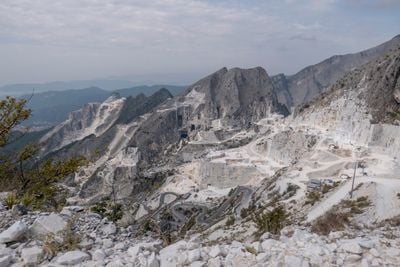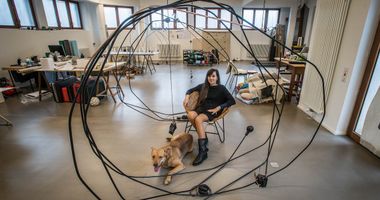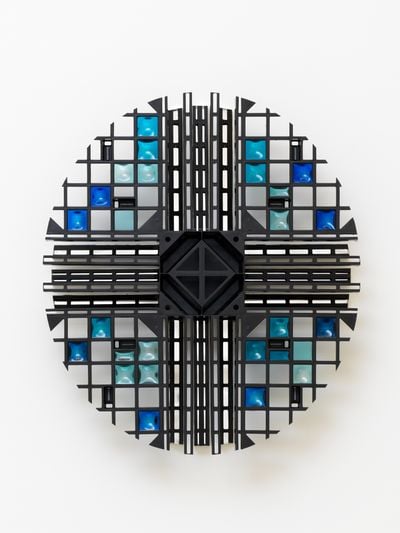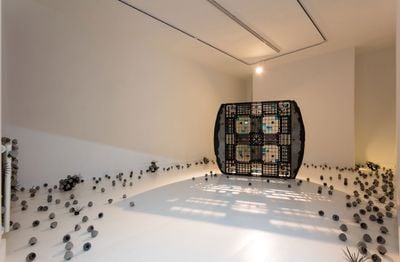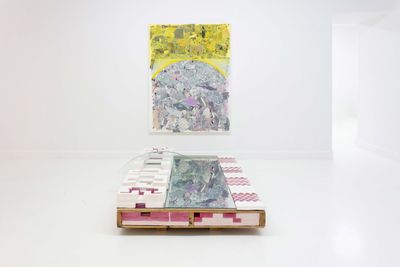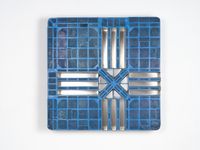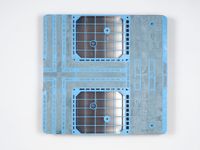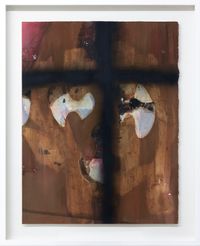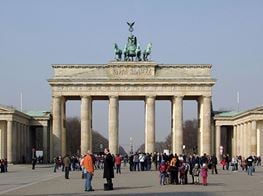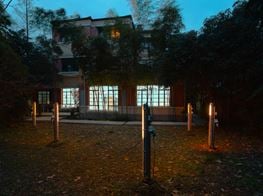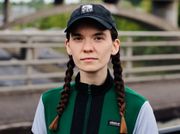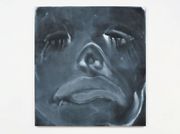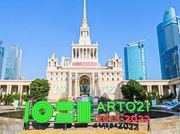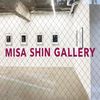Leelee Chan: Materialising Hong Kong's Fluctuations
Leelee Chan (2020). Courtesy the artist and Capsule Shanghai. Photo: Janelle Chiang.

Leelee Chan (2020). Courtesy the artist and Capsule Shanghai. Photo: Janelle Chiang.
Whether scavenged plastic pallets or Ming dynasty Chinese pottery, all materials are assigned equal value in Leelee Chan's sculptures.
Chan received her MFA in Painting from the Rhode Island School of Design in 2009—an experience that was formative in her approach to sculpture, with the poetics of colour and the intimate viewing experience of painting being some of the qualities she has integrated into her sculptures.
At its core, Chan's practice is concerned with the value and potential of materials, and her sculptures mirror and draw from the fabric of Hong Kong's packed urban environment. Among the items she collects from the city's streets is asphalt—jagged pieces of its glittering surface arranged into a circle in Absorber #2 (2017).
Plastic pallets also feature in Chan's recent sculpture Hazy Blue Silhouette (2021). Shown at Capsule Shanghai's booth at Art Basel Hong Kong last year, the work fuses a blue palette with stainless steel, lapis lazuli, acrylic resin, pigment, polystyrene foam, and construction adhesive—a combination inspired by the 'fleeting experience' of walking around the city, observing the sky's reflections on Hong Kong's skyline.
Hazy Blue Silhouette is part of the artist's 'Pallet In Repose' series (2019–2021), an expansion of which will be on view in Antinomies at Klemm's in Berlin (17 September–29 October 2022) as part of Berlin Art Week, 'albeit with a more dynamic experimental approach to form, materials, meanings, and associations,' Chan notes.
In 2020, Chan was awarded the 9th BMW Art Journey, a joint initiative between Art Basel and BMW that enables artists to travel and research to create new work. For her Journey, Chan engaged with artisans, innovators, and scientists around the globe to explore the evolving meanings of eight materials—silver, copper, iron, obsidian, concrete, mosaic, marble, and mycelium—and their roles in the course of history.
Central to this experience were her encounters. In Italy, she met with the last remaining blacksmith of Lucca province, Carlo Galgani, while Franco Gerbasi and Filipino D'Aloise in Agnone in Molise Province are among the last coppersmiths of the town, which had been a central hub for copper production in the Middle Ages.
Spanning ancient crafts and future materials, Chan's artistic inquiry collapsed different temporalities, as is characteristic of her practice. Recently, she has been tapping into her family's own experience with ancient objects, with her parents having owned an antiques shop in Hong Kong.
Last year, she participated in the group exhibition Up Close – Hollywood Road II organised by Nan Fung Group and curator MUSTHAVEKEYS to form a dialogue between arts and ancient objects. Her series 'Present Relics' (2021) brings together elements from Ming dynasty figures with seashells and steel, creating unexpected combinations.
In this interview, Chan discusses her unique approach to sculpture as well as the influence of the BMW Art Journey on her inquiry into the past, present, and future of different materials.
TMI wanted to start with the BMW Art Journey, and the influence of this experience on your practice. How do you see it impacting you as an artist in the years to come?
LCFor my journey, instead of completing a singular project, I chose to focus on materials, which are an essential part of my practice, and go as deep as possible beyond the surface of materiality.
Initially, I wanted to focus on my encounters with people and communities whose lives and identities were shaped by six ancient materials—silver, copper, iron, obsidian, mosaic, and marble. I was interested in the ecological impact of their extractions and their craftsmanship heritage. While they have an ancient history, they continue to be used and have relevance in contemporary life.
I was also intrigued by the sustainable alternatives to materials I used in my works, such as mycelium and low-carbon emission concrete. I chose materials that have profoundly impacted human civilisation to understand material culture and materiality from the ground level. During a time when everyone was trying to keep their distance from each other, this felt particularly significant.
I am glad to say that I have made personal connections that have lasted longer than the duration of my journey. For example, for my upcoming solo show Antinomies at Klemm's in Berlin, I collaborated with marble-stone artisans from Pietrasanta in Italy, whom I met during my journey.
I have also thought deeply about how I can utilise the knowledge I gained during my journey in the context of my daily studio practice. In Hong Kong, we get most of our materials from China since many related industries are not located here anymore.
The reality of being a contemporary artist in Hong Kong means ordering all kinds of materials from Taobao [a Chinese online shopping and service platform] via essentially shopping through jpegs. Although very convenient, you decide which materials to use entirely remotely.
It also means that you have no idea where this 'stuff' initially comes from, who is extracting and producing it, or what people in those communities think about the materials in relation to their changing roles in the time of globalisation.
My journey was very much about tracing the origins of materials, and this is something I still think about a lot when working in my studio today. I can never think of materials the same way as before.
TMThese different facets of material production, whether craftsmanship, artistry, or their use in the scientific realm, are all components of your practice, especially when thinking about your parents' background selling antiques.
You have combined antique objects within your artworks, as seen in your inclusion in the group exhibition Up Close – Hollywood Road. Have the different encounters with craftspeople and artisans during your BMW Art Journey brought you back to your family history, in a sense?
LCYes, definitely. After talking to artisans in Italy and Mexico, I was struck by the vast difference between those who chose to work with the materials, sometimes uprooting their lives on different continents to be closer to the materials, and those who joined out of economic necessity or to utilise the specific skills they acquired from their families throughout generations.
I did not 'choose' to grow up near antiquities but made a conscious decision to return to Hong Kong partly to reconnect with my roots.
Learning restoration techniques from my parents also contributed to my wanting to avoid being purely a spectator. In Italy, I learned to make mosaics using an ancient method from a mosaic artisan who is also a conservator of early-Roman mosaics in Ravenna, Italy.
Once I arrived in Mexico, I spent days with my local guide tracking down obsidian miners and visiting various abandoned and still-operating silver mines. It was also the first time I learned about the Manila galleon—Spanish trading ships, which for two-and-a-half centuries linked the Spanish Crown's Viceroyalty of New Spain, based in Mexico City, with its Asian territories across the Pacific Ocean.
I also learnt about the importance of the Ruta de la Plata [Silver Route] for the Ming dynasty currency supply. A third of the silver produced in Spanish America ended up in China. In contrast, the trade path between Manila and Acapulco took the first large wave of Chinese immigrants to the Americas. Mexico City already had a Chinatown in the 1600s.
In one of the many memorable moments, I had a chance encounter with an 82-year-old blacksmith in a village in Lucca, Italy, who is still forging iron in a water-powered forge mill that his family started in mediaeval times. The following day I found myself in a high-tech research laboratory in Lausanne, Switzerland, interviewing a world-leading female scientist who invented low-carbon emission cement.
What all this taught me is that progression is not necessarily linear. By contrast, past, present, and future materials are all equally important and overlapping, and how we look at them continues to evolve. This is a notion I will continue to explore because materials and objects reflect who we are and who we are becoming as individuals and a society.
TMThere's an element of your practice that mirrors the compressed landmass of Hong Kong.
How does this relate to Hong Kong's shifting fabric as a city, particularly when thinking about how you're elevating materials such as plastic palettes and asphalt as archaeological records and assigning them value?
LCHong Kong's shifting fabric as a city has always had a subliminal influence on me and my sculpture. My studio is in an industrial building surrounded by many logistics companies and warehouses. I see pallets scattered on the street and asphalt pieces broken off the road almost daily. They reflect the built environment of my immediate surroundings in Hong Kong.
Many lorries load and unload goods outside my studio building daily, which echoes my thinking about Hong Kong as a city that is always in a busy state of flux. As part of the accelerating global supply chain, the pallets impart a steady state of movement and change. They also hold special meaning for me as I grew up overseeing the 24-hour container port from my apartment window.
But Hong Kong's heritage has also influenced some of my works more directly. For instance, after returning from my journey, I was engaged with a project commissioned by Tai Kwun Contemporary using granite stored at the Hong Kong Jockey Club, which was used to build the former Central Police Station compound, now Tai Kwun. By creating the sculpture Pallet in Repose (Barren Rock) (2021) at Tai Kwun, the granite was returned to the site for which it was intended, yet in a completely different context.
What all of this taught me is that progression is not necessarily linear. By contrast, past, present, and future materials are equally important.
In Hong Kong, granite has been used for land reclamation, shaping the land. As one of the earliest export products, granite played a crucial role in Hong Kong's development into an international trading port. The quarry industry was run by people in the Guangdong province and existed before the British arrived. There is a complex history of how the British used granite to create the myth of Hong Kong as an economic miracle, transforming what they called a 'barren rock'.
Other elements in my works spoke to the shifting fabric of Hong Kong as a city. For instance, one of my older works, Imagery Boundary (2018), was inspired by a historical relic, boundary stones, which used to mark the confines of Victoria, the former capital of Hong Kong during the British colonial period. Ironically, once a symbol of early Hong Kong history and identity, none of the boundary stones today are legally protected against damage and demolition.
Imagery Boundary is not intended as a replica of this missing stone. Instead, it tries to capture contemporary Hong Kong's relationship between the natural and artificial, past and present, public and private, and the internal and external hybrids of everyday life.
[The materials] all serve human needs, but how they contribute to the city in flux differs.
While capturing the shifting fabric of Hong Kong in different ways, there is an intriguing contrast between the materials I used. Granite and boundary stones present a permanent method of shifting and mapping the landmass in Hong Kong. By comparison, pallets and asphalt function as a manufactured temporary 'grounding' for roads, tennis courts, and industrial production invented to improve human performance for economic purposes, endlessly replaced and expanded. They all serve human needs, but how they contribute to the city in flux differs.
TMIn all these scenarios—building underneath and above the ground—the impact is more or less the same, as the ground is imploded to make way for human needs.
LCYes, I agree. There is an exciting aspect when comparing space in Hong Kong to my experiences of being inside the underground silver mines in Mexico and on top of the marble quarries in the Apuan Alps in Italy. I visited many such mines, some abandoned, but others have been functioning since ancient times.
In each location, humans have created an irreversible modification of the morphology.
Local people still try to extract silver from some abandoned mines, which is dangerous because there is not always safety equipment on site. Being inside these mines felt dark, damp, and claustrophobic. There was a stark contrast between being in this space underground, which makes one feel highly vulnerable, and being in the light and open Carrara marble quarries. Indeed, the sense of light was so intense because the whiteness of the marble dust reflected the light.
In Hong Kong, the architectural landscape expands upwards, but my sense of space in Mexico was drawn down into the mines. In Carrara, the marble quarries are eating away at the mountains with an ever-accelerating speed and precision due to technological advances. By contrast, in Hong Kong, many discussions surround the issue of land use and land reclamation.
I found these different senses of space and how, as humans, we continue to shape our surroundings based on our needs, desires, and greed very inspiring. In each location, humans have created an irreversible modification of the morphology.
TMYou have mentioned that while your work draws attention to the urban environment, it is not necessarily reflecting on sustainability or environmental issues. Yet the book exploring your BMW Art Journey, launched at Art Basel Hong Kong 2022, touches on your exploration of materials and their future use. Do you arrive at environmental issues more indirectly?
LCI am conscious of the materials' relations to socioeconomic issues, but at the same time, I'm not an environmental artist, and I don't take claiming the word 'environmentalist' lightly. As an environmentalist, it would be tough to justify the art I make.
I always think about whether there are alternatives to certain materials and whether the sculpture could be produced on a more moderate scale. Then, there is the concern about the local ecology from where the materials originate and whether they could be sourced locally. This is not even touching upon the many ethical and justice issues related to the materials' extraction. Sometimes it's hard to find a morally acceptable balance but being aware is important.
TMYou were initially trained as a painter, right? I remember visiting your exhibition at Capsule Shanghai in 2019, which included some beautiful, collaged paintings.
LCTotally. I got both my BFA and MFA degree in Painting. I made abstract paintings alongside some small sculptures for ten years after I finished graduate school. Sculpture only became my primary medium after my first solo show at Capsule Shanghai.
The language of abstraction, especially composition, really benefits my sculpture. It enables me to create movement and rhythm by arranging different elements in space and blurring the lines between material surface and depth, or the interior and exterior.
I want my sculptures to have a sense of becoming even when standing still. Adding to the composition, colours are great tools to play with viewers' perceptions and provoke a particular atmosphere and feeling, which has psychological depth. I regard this as an 'activation' of the materials and objects in my sculptures, which in turn creates a more intimate viewing experience.—[O]

